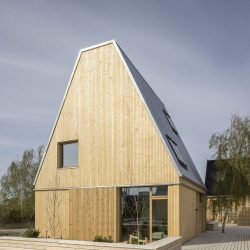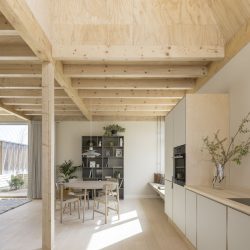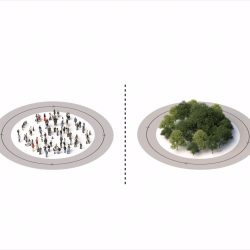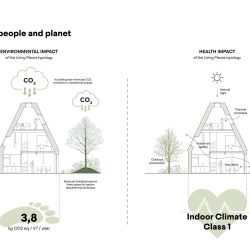
EFFEKT . photos: © Adam Mørk
Living Places Copenhagen showcases a new way of thinking – one that is centred around building a better living environment that benefits both people and the planet. The seven prototypes – five open pavilions and two completed full-scale homes – show how we can develop more sustainable homes with a three times lower CO2 footprint and a first-class indoor climate. The Living Places concept holds the lowest CO2 emissions in Denmark, demonstrating that we do not have to wait for future technology to build more sustainably.
The vision of the overall concept – Living Places – which was initiated by EFFEKT, Artelia and the VELUX Group, is to lead the way within the building industry and show how rethinking buildings can help solve some of the global climate and health challenges. We envisioned an open-source development model that enables a new holistic approach to construction by factoring in the entire lifecycle. The concept is based on five key principles: homes should be healthy, affordable, simple, shared over time and scalable. These principles can be applied to new or existing buildings and communities.
In the latest report from the UN’s climate panel, it is clear that low carbon solutions must be scaled and implemented – also in the building industry. Living Places Copenhagen demonstrates a new way of building homes with a CO2 footprint of 3.8 kg/CO2/m2/year – three times lower than the current Danish legislation of 12 kg CO2/m2/year – and to a price that matches the market price for a one-family house or rowhouses at scale. Furthermore, Living Places Copenhagen is designed with a strong focus on creating a healthy indoor climate using daylight and fresh air and it delivers best in class indoor climate.
The materials, solutions and knowledge are already here
As a part of The Living Places Copenhagen project in Jernbanebyen, EFFEKT, Artelia, the VELUX Group and Enemærke & Petersen, have carried out a complete Life Cycle Assessment. This means that the implications of each material, design choice and building technique has been carefully considered and mapped in terms of the emissions they project compared to a typical Danish household. By separating technical systems and building systems we use circular economy as a means to extend the building’s lifetime and reduce cost, labor and waste. Based on this, the partnership has built prototypes, showing that we do not have to wait for future technology to build homes that benefit both people and the planet.
To go with the prototypes we have developed “the Compass Model” to guide the design and building process and provide stakeholders and collaborators with a framework for navigating the sustainability imperatives of the moment while encouraging the design of healthier living places, It comprises seven strategic drivers: flexibility, quality, environment, health, community, local, affordability.
As an official partner to the UIA World Congress of Architects in Copenhagen, Living Places Copenhagen will host a programme of debates and activities throughout 2023 designed to drive and accelerate change in the building industry.
_




























